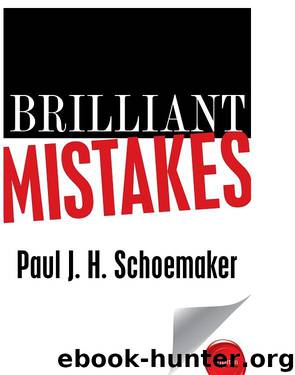Brilliant Mistakes by Paul J. H. Schoemaker

Author:Paul J. H. Schoemaker
Language: eng
Format: epub
ISBN: 9781613630112
The Paradox of Deliberate Mistakes
The phrase “deliberate mistake” contains an element of paradox that may not sit well with more exacting readers. Is a deliberate mistake truly an error—or is it, by definition, a purposeful act of testing or experimentation?
The answer to this question depends on how you view the human mind. In the classic economic definition of human thought, the human mind is unitary. It is presumed that an individual operates from a single, consistent mind-set, with beliefs and values all in alignment. Traditional economics is built on this rationality assumption. It is assumed that each individual has clearly articulated, consistent preferences (measured via utility functions) and also that each person holds coherent beliefs (measured via subjective probabilities). This hyper-rational view of humans can be a useful fiction, especially as a first-order approximation in traditional economic models, but it’s not what I assume here.
Instead, I ask you to view the human mind as operating at multiple levels at once, with alternative and sometimes even competing points of view. Imagine this as multiple persons residing within a single mind. And, no, don’t worry—I’m not talking about the Freudian struggle between the id and the superego or invoking the notion of multiple personalities. I am simply referring to the way in which a person can be of two minds about a complex issue. This more nuanced view of thinking has been common in psychology and is increasingly gaining traction in economics as well, as the fields of behavioral finance and economics continue to grow. Since this view underlies my case for the strategy of purposeful mistakes, let’s examine it in some more depth.
The human mind contains multiple layers of functioning, but for the sake of simplicity, let’s start with just two. Cognitive psychologists refer to the two primary functions of our minds as System 1 and System 2. These two systems correspond to what some call “right and left brain” and others call “intuition versus analytical reasoning.” But since these terms carry long legacies and tend to drag in other preconceived notions, cognitive psychologists prefer the neutrality and clinical detachment of their labels. Here is how the 2002 Nobel laureate in economics, Professor Daniel Kahneman, a leading cognitive researcher, explains the distinction. System 1 thinking is the most common and comprises “thoughts that come to mind on their own.” As Kahneman describes it, “It’s not like we’re on automatic pilot, but we respond to the world in ways that we’re not conscious of, that we don’t control.” When operating in System 1 mode, our thoughts are “fast, effortless, associative, and often emotionally charged; they’re also governed by habit, so they’re difficult either to modify or to control.”
For illustration’s sake here, let’s think of System 1 thought as a person, and let’s call that person Jessie. Jessie is impulsive and emotional, maybe a little unpredictable, and usually operates from intuition or gut instinct rather than long deliberation. System 2 thought, in contrast, is our reason-driven mode. As described by Kahneman: “System 2 is .
Download
This site does not store any files on its server. We only index and link to content provided by other sites. Please contact the content providers to delete copyright contents if any and email us, we'll remove relevant links or contents immediately.
Hit Refresh by Satya Nadella(9038)
The Compound Effect by Darren Hardy(8808)
Change Your Questions, Change Your Life by Marilee Adams(7634)
Nudge - Improving Decisions about Health, Wealth, and Happiness by Thaler Sunstein(7615)
The Black Swan by Nassim Nicholas Taleb(7010)
Deep Work by Cal Newport(6877)
Daring Greatly by Brene Brown(6444)
Rich Dad Poor Dad by Robert T. Kiyosaki(6399)
Principles: Life and Work by Ray Dalio(6206)
Man-made Catastrophes and Risk Information Concealment by Dmitry Chernov & Didier Sornette(5921)
Playing to Win_ How Strategy Really Works by A.G. Lafley & Roger L. Martin(5914)
Digital Minimalism by Cal Newport;(5661)
Big Magic: Creative Living Beyond Fear by Elizabeth Gilbert(5610)
The Myth of the Strong Leader by Archie Brown(5424)
The Slight Edge by Jeff Olson(5346)
Discipline Equals Freedom by Jocko Willink(5283)
The Motivation Myth by Jeff Haden(5155)
Stone's Rules by Roger Stone(5026)
The Laws of Human Nature by Robert Greene(4996)
